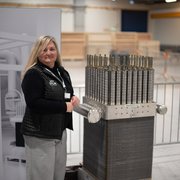AI is expected to drive a 160 percent increase in data center power demand by 2030 and recent headlines have been rife with examples of how big tech companies are (and aren’t) prepared to meet that demand and mitigate emissions. Most notably, in its latest environmental report Google announced that, beginning in 2023, it is “no longer maintaining operational carbon neutrality." Meanwhile, an investigative piece by Bloomberg also highlighted that Google’s total planet-warming emissions in 2023 were 48 percent higher than 2019 and in that period, its total energy consumption also doubled.
Per the Rocky Mountain Institute, “the United States is witnessing an unprecedented surge in data center power demand. Data center electricity consumption was 2.5 percent of the US total (~130 TWh) in 2022.” The Boston Consulting Group projects that total data center power demand will increase by 15-20 percent annually to reach 100-130 GW (800-1,050 TWh) by 2030. That’s the equivalent of the electricity used by about 100 million US houses – about two-thirds of the total homes in the US.
Data centers need massive amounts of energy for their operations and require stable, reliable power sources to remain in operation. But when that power is drawn from a majority fossil fuel-powered grid, emissions soar.
Big tech companies, industrial entities, manufacturers, and more are increasingly turning to carbon offsets or investments in carbon removal technologies to curb their growing emissions and illustrate their commitment to sustainability. This is not enough.
Growth in power demand cannot reverse decarbonization plans and increase emissions throughout our communities. Large energy users – including data centers – must not increase demand for more new methane and carbon combustion power technologies.
Any new natural gas, coal, or fossil fuel plant will be built and operated for decades, locking in emissions for years to come, and will only enable the continued volatility of fossil fuel prices as compared to the price certainty of renewables.
The main obstacles to decarbonizing data centers are supply sufficiency, carbon intensity, grid access, grid reliability, and sustainable pricing, but there are scalable, dispatchable carbon-free energy solutions ripe for investment opportunity – including off-grid green hydrogen production and storage.
Everybody wants power - off-grid solutions can deliver
While big tech and AI operations are getting most of the attention, nearly all industries are grappling for access to power. And overall demand for energy continues to rise - Enerdata reported that global energy consumption accelerated by +2.2 percent in 2023, greatly outpacing the average 2010-2019 growth rate of +1.5 percent per year.
Environmental concerns, emissions reporting requirements, policy actions, and more have shifted much of this growing demand toward renewable power sources. While the renewable energy industry is booming and many promising innovations can be deployed to decarbonize power generation, this presents another challenge: grid congestion. New data center capacity schedules and years-long queues to connect renewable assets to the grid are slowing progress toward a cleaner energy future.
One solution? Turn to off-grid renewables, which are not beholden to the grid’s limitations and notorious regulatory processes.
Powering hydrogen production with dedicated, off-grid renewable resources like solar and wind, elevates hydrogen from simply a clean fuel to a vital component in our quest to reach reliable renewable energy.
Data centers and other energy-intensive sectors that adopt off-grid green hydrogen solutions will reduce reliance on utility power grids and avoid frustrating interconnect delays. They can also say with confidence that their operations are not contributing to grid congestion and instability. All this while ensuring critical operations can meet and maintain their current demand trajectory without creating new emissions.
Sustainability without sacrificing reliability
Large energy users like data centers don’t just need a lot of clean energy - they need their energy sources to be reliable. When a site provides power for digital infrastructure, telecommunications, or other critical sectors, a small outage or disruption could be costly and dangerous.
This challenge is well-known to industry players and policymakers. In 2021, the 24/7 Carbon Free Energy (CFE) Compact was introduced by a diverse group of businesses and government entities – including Google – during the United Nations High level Dialogue on Energy. By their definition, “24/7 Carbon-free Energy (CFE) means that every kilowatt-hour of electricity consumption is met with carbon-free electricity sources, every hour of every day, everywhere.” The Compact acknowledges that the transition to a fully decarbonized energy sector is possible thanks to continued industry-wide innovation and introduces actions stakeholders can take to drive progress.
Strategically pairing long-duration storage with generation means hydrogen can be deployed consistently and continuously to meet changes in demand – even when the renewable energy sources powering its production aren’t running.
This approach transforms notoriously intermittent generation like solar and wind energy into firm, dispatchable assets capable of driving decarbonization across many sectors. More broadly, scaling up off-grid hydrogen production and storage can help our energy system reach the sought-after goal of 100 percent renewable generation.
Reliability and sustainability can go hand in hand in an industrial decarbonization strategy if industries act with urgency. We must invest in and scale dispatchable, carbon-free energy solutions - humanity is dependent on it! Twenty-four/seven, clean and reliable hydrogen is one option that stands to benefit large energy users – and data centers specifically.




